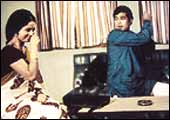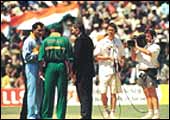|
 You
can read the news today from any of the 6,830 English or 39,825
vernacular newspapers published in India; catch it on the tube-22
terrestrial and over 100 satellite channels, with eight devoted
to news; log on and surf the net for the latest; or get the days
headlines on your mobile. You
can read the news today from any of the 6,830 English or 39,825
vernacular newspapers published in India; catch it on the tube-22
terrestrial and over 100 satellite channels, with eight devoted
to news; log on and surf the net for the latest; or get the days
headlines on your mobile.
Weaned on a diet of democracy, the average
Indian has grown to take a few rights for granted. These include
the right to speak, to write, to listen, to read, and to share ideas.
It is perhaps a function of this that India has done extraordinarily
well in the business of ideas. And also that India has amongst the
most thriving media and communication industries in Asia.
Numbers bear this out: with 70 million television
households India boasts the third largest television market in the
world; with a cumulative circulation exceeding 12 crore, its print
industry ranks fifth globally; and while regulatory constraints
have choked its telecommunications industry, consulting outfit Gartner
expects the number of cellular phone subscribers in India to soar
to 30.9 million in 2005.
The success of the media and communication
business in India is built around what MIT Media Lab's Nicholas
Negroponte calls ''the ability of the small man to be heard''. That's
true of Italy, and while Negroponte's observation holds for both
countries that it is neither a sufficient nor a necessary condition
to the dispersion of a particular medium becomes evident when one
looks at China. The country everyone will have to compete with-the
stake is the political and economic dominance of the world, a position
the US enjoys today-boasts over 100 million cellular subscribers.
A far more convincing explanation for the success
of the media and communications businesses in Italy and India could
be the shared traits of their peoples: family-oriented, religious,
indolent, and with a love of the spoken word (especially their own).
Circa 2002, Indian media has come a long way
from beginnings associated with the Indian freedom movement. Post-independence,
the government took upon itself the role of information disseminator.
Radio and television weren't media in the contemporary sense; they
were instruments to achieve social objectives. All too often that
meant propaganda, and it was left to the print media to present
an unbiased view.
If the government's efforts to adopt mass-media
to its own ends failed, then its attempts to engender a telecom
revolution fared no better. India has just 26 phones for 1,000 people.
Today, the private sector is present in both
telecommunications and broadcasting. A bouquet of private satellite
channels has segmented the market in terms of viewership and advertising.
A rise in literacy levels has spurred a resurgence in the vernacular
print media. India's two largest newspapers and the television channels
with the largest following in the country are vernacular ones. Satellite
television-there are 35 million C&S (cable and satellite) households
in the country-reflects the aspirational changes in the Indian middle
class, sometimes even influences them. And even as the debate to
allow foreign investment in print media continues-it is, in every
other medium-Indian media houses are discovering that there is a
middle path: one that balances the profit-motive with the need for
objectivity.
Subliminal
Persuasiveness
 |
| The coverage of General Election 1998: Influencing
minds? |
There's something
sinister, in an almost Goebbelsian sort of way, about media's much-touted
role as a shaper and changer of opinions. Fact is, media has traditionally
played little part in influencing decisions, especially when these
relate to India's largest marketing event, the General Elections.
'Traditionally', because, its importance as an opinion-shaper is
growing. Driving this growth is the shift from print to television-not
in terms of a classic viewership vs readership debate, but in terms
of the different ways in which people read and watch television.
Print is a cerebral medium. It is meant for
the super-literate (the wholly Indian tactic of classifying people
as literate if they can read and sign their own names prevents us
from using the word without a qualification). Ergo, it impacts opinions,
not ways of life. Television images, in contrast, completely bypass
the cognitive process. They offer bit-sized packages that can be
easily consumed. Politicians, more than media professionals, seem
to realise this: the television-savvy among them, from Jayalalithaa
to Laloo Yadav to Pervez Musharraf, take to the medium like a duck
to water; the rest stumble on, their foibles visible for the world
to see and dissect.
But it isn't in the political domain that television
has its most significant impact: it is in the business domain. Images
of consumerism, and consumerist lifestyles in feel-good soaps work
better than references to Lux's salutary impact on skin types in
the earliest American radio soaps (yes, the product was written
into the script). When this happens, the medium truly becomes the
message.
-Shailesh Dobhal
|
Programmes
That Revolutionised Televison...
...well, almost. This subjective list was drawn up with
the assistance of media planners.
P.S.: Even they couldn't remember the years, a sign of the
ephemeral nature of televison.
|
 |
 |
 |
| Chitrahaar, 1974, DD: song and dance time
and the pioneer |
Ramayan, 1987, DD: Religion and television
make a potent combo |
Cricket World Cup, 1996: the India Pak
match attracts 10 crore viewers |
|
|
|
|
| Hum Log, 1984, DD: The soap (op)era begins |
Chanakya, 1991, DD: perhaps the last of DD's superhits |
Amanat, 1997, Zee: a serial that shaped Zee's fortunes |
|
|
|
|
| |
Bold And The Beautiful, 1992, Star: a
soap that started the cultural invasion |
KBC, 2000, Star Plus: the programme that
turned around a channel |
|
|
|
|
| Yeh Jo Hai Zindagi, 1984, DD: viewers
still remember its sponsor Vicco |
Tara, 1993, Zee: India's first female-centric
soap |
Kyunki Saas Bhi Kabhi Bahu Thi, 2000, Star
Plus: the return of family-oriented soap |
|
|
|
|
| Buniyad, 1986, DD: the first of the mega
soaps |
Shanti, 1994, DD: a big day-time |
Chithi, 2001, Sun TV: a success that inspired
translation |
|

